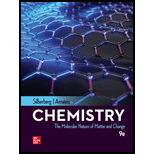
Concept explainers
(a)
Interpretation:
The
Concept introduction:
Henry’s law gives the quantitative relationship between the pressure of the gas and its solubility. It states that the amount of gas dissolved in a liquid is proportional to the partial pressure of the gas. Higher the partial pressure of the gas, more will be its solubility and vice-versa.
The formula to calculate the solubility of gases according to Henry’s law is as follows:
Here,
(b)
Interpretation:
The molarity of
Concept introduction:
Molarity is defined as the number of moles of solute that are dissolved in one litre of solution. It is represented by
The formula to calculate the solubility of gases according to Henry’s law is as follows:
(c)
Interpretation:
The mole fraction of
Concept introduction:
The mole fraction is defined as the ratio of the number of moles of solute to the total number of moles in the mixture. It is represented by
The formula to calculate the mole fraction is as follows:
(d)
Interpretation:
The concentration of
Concept introduction:
The
The formula to calculate the concentration of an ion in
Want to see the full answer?
Check out a sample textbook solution
Chapter 13 Solutions
CHEMISTRY:MOLECULAR...(LL)-W/CONNECT
- What is the name of the following compound? SiMe3arrow_forwardK Draw the starting structure that would lead to the major product shown under the provided conditions. Drawing 1. NaNH2 2. PhCH2Br 4 57°F Sunny Q Searcharrow_forward7 Draw the starting alkyl bromide that would produce this alkyne under these conditions. F Drawing 1. NaNH2, A 2. H3O+ £ 4 Temps to rise Tomorrow Q Search H2arrow_forward
 ChemistryChemistryISBN:9781305957404Author:Steven S. Zumdahl, Susan A. Zumdahl, Donald J. DeCostePublisher:Cengage Learning
ChemistryChemistryISBN:9781305957404Author:Steven S. Zumdahl, Susan A. Zumdahl, Donald J. DeCostePublisher:Cengage Learning ChemistryChemistryISBN:9781259911156Author:Raymond Chang Dr., Jason Overby ProfessorPublisher:McGraw-Hill Education
ChemistryChemistryISBN:9781259911156Author:Raymond Chang Dr., Jason Overby ProfessorPublisher:McGraw-Hill Education Principles of Instrumental AnalysisChemistryISBN:9781305577213Author:Douglas A. Skoog, F. James Holler, Stanley R. CrouchPublisher:Cengage Learning
Principles of Instrumental AnalysisChemistryISBN:9781305577213Author:Douglas A. Skoog, F. James Holler, Stanley R. CrouchPublisher:Cengage Learning Organic ChemistryChemistryISBN:9780078021558Author:Janice Gorzynski Smith Dr.Publisher:McGraw-Hill Education
Organic ChemistryChemistryISBN:9780078021558Author:Janice Gorzynski Smith Dr.Publisher:McGraw-Hill Education Chemistry: Principles and ReactionsChemistryISBN:9781305079373Author:William L. Masterton, Cecile N. HurleyPublisher:Cengage Learning
Chemistry: Principles and ReactionsChemistryISBN:9781305079373Author:William L. Masterton, Cecile N. HurleyPublisher:Cengage Learning Elementary Principles of Chemical Processes, Bind...ChemistryISBN:9781118431221Author:Richard M. Felder, Ronald W. Rousseau, Lisa G. BullardPublisher:WILEY
Elementary Principles of Chemical Processes, Bind...ChemistryISBN:9781118431221Author:Richard M. Felder, Ronald W. Rousseau, Lisa G. BullardPublisher:WILEY





